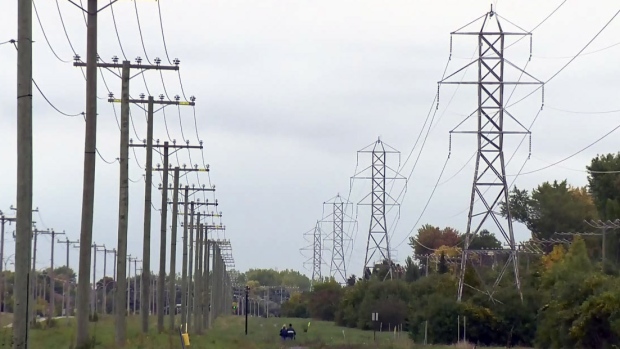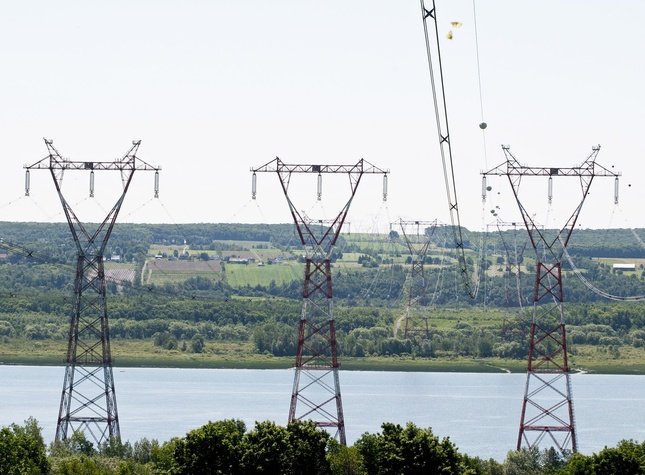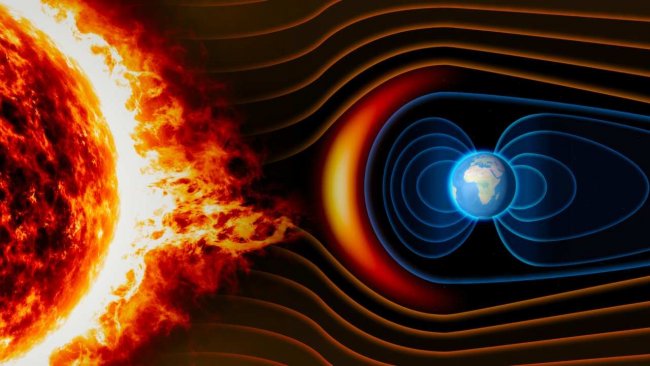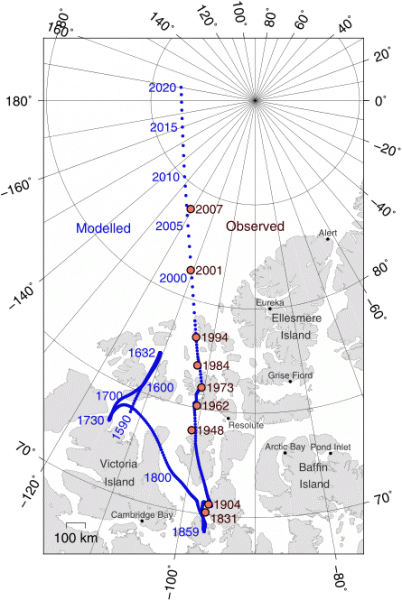What is the magnetosphere and how strong magnetic storms affect technology
Our Earth is magnet — this is known to all. The magnetic field lines leave the area of the south magnetic pole and enter the area of the north magnetic pole. Recall that Earth's magnetic and geographic poles are slightly different—in the northern hemisphere, the magnetic pole is shifted about 13° towards Canada.
The set of lines of force of the Earth's magnetic field is called magnetosphere… Earth's magnetosphere is not symmetrical about the planet's magnetic axis.
On the side of the Sun it is attracted, on the opposite side it is lengthened. This shape of the magnetosphere reflects the constant influence of the solar wind on it. Charged particles flying from the Sun appear to "squeeze" the lines of force magnetic field, pressing them on the day side and pulling them on the night side.
As long as the Sun's situation is calm, this whole picture remains quite stable. But then there was sunlight. The solar wind has changed—the flow of its constituent particles has become greater, and their energy greater.The pressure on the magnetosphere began to increase rapidly, the lines of force on the day side began to move closer to the Earth's surface, and on the night side they were pulled more strongly into the "tail" of the magnetosphere. It is magnetic storm (geomagnetic storm).
During solar flares, massive explosions of hot plasma occur on the Sun's surface. During the eruption, a strong stream of particles is released, which move at high speed from the Sun to the Earth and disrupt the planet's magnetic field.
solar wind
"Compression" of the lines of force means the movement of their poles on the surface of the Earth, which means — a change in the strength of the magnetic field at any point on the globe... And the stronger the pressure of the solar wind, the more significant is the compression of the field lines, correspondingly, the stronger is the change in the field strength. The stronger the magnetic storm.
At the same time, the closer to the magnetic pole region, the more external field lines meet the surface. And they simply experience the greatest impact of the perturbed solar wind and react (displace) the most. This means that the manifestations of magnetic disturbances should be greatest at the geomagnetic poles (that is, at high latitudes) and smallest at the geomagnetic equator.
Shift of the magnetic north pole from 1831 to 2007.
What else is the described change in the magnetic field at high latitudes fraught with for us living on the surface of the Earth?
During a magnetic storm, power outages, radio communications, disruption of mobile operator networks and spacecraft control systems, or damage to satellites can occur.
A 1989 magnetic storm in Quebec, Canada caused severe power outages, including transformer fires (see below for details on this incident). In 2012, a severe magnetic storm disrupted communications with the European Venus Express spacecraft orbiting Venus.
Let's recall how the electric current generator works… In a stationary magnetic field, a conductor (rotor) moves (rotates). As a result, in the researcher An EMF appears and it starts flowing electricity… The same will happen if the wire is stationary and the magnetic field will move (change in time).
During a magnetic storm there is a change in the magnetic field, and the closer to the magnetic pole (the higher the geomagnetic latitude), the stronger this change.
This means we have a changing magnetic field. Well, and fixed wires of any length on the surface of the Earth do not occupy. There are power lines, railway tracks, pipelines...In a word, the choice is great. And in each conductor, by virtue of the above-mentioned physical law, an electric current arises, caused by variations in the geomagnetic field. We'll call him induced geomagnetic current (IGT).
The magnitude of induced currents depends on many conditions. First of all, of course, from the speed and strength of the change in the geomagnetic field, that is, from the strength of the magnetic storm.
But even during the same storm, different effects occur in different wires.They depend on the length of the wire and its orientation on the Earth's surface.
The longer the wire, the stronger it will be induced current… Also, it will be stronger the closer the wire orientation is to the north-south direction. In fact, in this case, the variations of the magnetic field at its edges will be the greatest and therefore the EMF will be the greatest.
Of course, the magnitude of this current depends on several other factors, including the conductivity of the soil beneath the wire. If this conductivity is high, the IHT will be weaker because most of the current will go through the ground. If it is small, the occurrence of severe IHT is likely.
Without going further into the physics of the phenomenon, we only note that IHTs are the main cause of the troubles that magnetic storms cause in everyday life.
An example of emergency situations caused by a strong magnetic storm and induced currents described in the literature
Magnetic storms of March 13-14, 1989 and emergency in Canada
Magnetologists use several methods (called magnetic indices) to describe the state of the Earth's magnetic field. Without going into details, we only note that there are five such indexes (the most common ones).
Each of them, of course, has its advantages and disadvantages and is most convenient and accurate in describing certain situations — for example, agitated conditions in the aurora zone or, conversely, the global picture in relatively calm conditions.
Naturally, in the system of each of these indices, each geomagnetic phenomenon is characterized by certain numbers — the values of the index itself for the period of the phenomenon, which is why it is possible to compare the intensity of geomagnetic disturbances that occurred in different years.
The magnetic storm of March 13-14, 1989 was an exceptional geomagnetic event according to calculations based on all magnetic index systems.
According to the observations of many stations, during a storm, the magnitude of the magnetic declination (deviation of the compass needle from the direction to the magnetic pole) within 6 days reaches 10 degrees or more. This is a lot, considering that a deviation of even half a degree is unacceptable for the operation of many geophysical instruments.
This magnetic storm was an extraordinary geomagnetic phenomenon. However, the interest in it would hardly have exceeded a narrow circle of specialists, if not for the dramatic events in the life of a number of regions that accompanied it.

At 07:45 UTC on 13 March 1989, high-voltage transmission lines from James Bay (northern Quebec, Canada) to southern Quebec and the northern states of the United States, as well as the Hydro-Québec network, experienced strong induced currents.
These currents created an additional load of 9,450 MW on the system, which was too much to add to the useful load of 21,350 MW at the time. The system went down, leaving 6 million residents without electricity. It took 9 hours to restore the system to normal operation. Consumers in the northern US at that time received less than 1,325 MWh of electricity.
On March 13-14, unpleasant effects associated with induced geomagnetic currents were also observed on the high-voltage lines of other power systems: protective relays worked, power transformers failed, voltage dropped, parasitic currents were recorded.
The largest induced current values on March 13 were recorded in the Hydro-Ontario (80 A) and Labrador-Hydro (150 A) systems. You don't need to be an energy expert to imagine the damage that can be done to any power system by the appearance of stray currents of this magnitude.
All this affected not only North America. Similar phenomena have been observed in a number of Scandinavian countries. It is true that their effect was much weaker due to the fact that the northern part of Europe is further from the geomagnetic pole than the northern part of America.
However, at 08:24 CET, six 130-kV lines in central and southern Sweden recorded a simultaneous current-induced voltage surge but did not reach an accident.
Everyone knows what it means to leave 6 million residents without electricity for 9 hours. That alone would be enough to draw the attention of specialists and the public to the March 13-14 magnetic storm. But its effects were not limited to energy systems.

Also, the US Soil Conservation Service receives signals from numerous automatic sensors located in the mountains and monitoring soil conditions, snow cover, etc. on the radio on frequency 41.5 MHz every day.
On March 13 and 14 (as it turned out later, due to the superposition of radiation from other sources), these signals were of a strange nature and either could not be deciphered at all, or indicated the presence of avalanches, floods, mudflows and frost on the ground at the same time...
In the US and Canada, there have been cases of spontaneous opening and closing of private garage doors whose locks were tuned to a certain frequency ("key") but were triggered by the chaotic overlap of signals coming from afar.
Generation of induced currents in pipelines
It is well known what a large role pipelines play in the modern industrial economy. Hundreds and thousands of kilometers of metal pipes pass through different countries. But these are also conductors and induced currents can occur in them too. Of course, in this case, they cannot burn out a transformer or relay, but they undoubtedly cause damage.
The fact is that to protect against electrolytic corrosion, all pipelines have a negative potential to ground of about 850 mV. The value of this potential in each system is kept constant and controlled. Significant electrolytic corrosion is considered to begin when this value drops to 650 mV.
According to the Canadian oil companies, on March 13, 1989, along with the onset of the magnetic storm, sharp spikes in potential began and continued on March 14. In this case, the magnitude of the negative potential for many hours is less than the critical value, and sometimes even drops to 100-200 mV.
Already in 1958 and 1972, during strong magnetic storms, due to induced currents, serious disturbances occurred in the operation of the transatlantic telecommunications cable. During the storm of 1989a new cable was already in operation, in which information was transmitted over an optical channel (see — Optical communication systems), so there are no violations in the transmission of information.
However, three large voltage spikes (300, 450 and 700 V) were recorded in the cable power system, which coincided in time with strong changes in the magnetic field. Although these spikes did not cause the system to malfunction, they were large enough to pose a serious threat to its normal operation.
The Earth's geomagnetic field is changing and weakening. What does it mean?
The Earth's magnetic field not only moves along the surface of the planet, but also changes its intensity. Over the past 150 years, it has weakened by about 10%. The researchers found that approximately once every 500,000 years, the polarity of the magnetic poles changes—the north and south poles switch places. The last time this happened was about a million years ago.
Our descendants may witness this confusion and possible disasters associated with polarity reversal. If there is an eruption at the time of the reversal of the magnetic poles of the Sun, the magnetic shield will not be able to protect the Earth and there will be a power outage and an interruption of navigation systems all over the planet.
The examples given above make one think about how serious and multifaceted the impact of strong magnetic storms can be on humanity's daily life.
All of the above is an example of a much more impressive effect of space weather (including solar flares and magnetic storms) than not very reliable correlations of solar and magnetic activity with human health.



